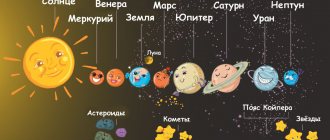Presentation on the topic “The Future of Space”
Presentation on the topic “The Future of Space” on astronomy in powerpoint format. This presentation for schoolchildren tells about how human space exploration proceeded, at what stage of development modern cosmonautics is and what space discoveries await the people of the future.
Fragments from the presentation
Space
- not only the lot of the courageous and brave. It is for the inquisitive and patient, savvy and firm, seeking and believing in the future of this as yet unknown world. Yu. A. Gagarin
Tsiolkovsky K. E. (1857 – 1953)
- 1903 published the work “Exploration of World Spaces by Reactive Instruments”
- For the first time in the world he described the main elements of a jet engine
- Deduced the relationship between the weight of the fuel and the weight of the rocket structure
- Analyze the behavior of a rocket outside the atmosphere;
- He expressed the idea of an on-board orientation system based on the Sun or other celestial bodies
October 4, 1957
The world's first satellite was launched into low-Earth orbit. This launch opened the space age in human history!
August 19, 1960
A spacecraft of the Vostok type was launched, with dogs Belka and Strelka, and with them 40 mice, 2 rats, various flies, plants and microorganisms, which flew around the Earth 17 times and landed.
Sam is the first chimpanzee astronaut launched into space on December 31, 1961.
from the Cape Canaveral Space Launch Center.
The accomplishment of the century.
April 12, 1961 Yuri Alekseevich Gagarin - the first man in space!
On June 16, 1963, the Vostok-6 spacecraft, for the first time in the world, was piloted by a woman, a citizen of the Soviet Union, cosmonaut Valentina Vladimirovna Tereshkova, into orbit.
First spacewalk
was accomplished by Soviet cosmonaut Alexei Arkhipovich Leonov on March 18, 1965.
From the Voskhod-2 spacecraft. The USSR sent two radio-controlled self-propelled vehicles to the Moon, Lunokhod 1 on November 17, 1970 and Lunokhod 2 in January 1973.
Space today
- The ISS is an international orbital station used as a multi-purpose space laboratory.
- The launch of the Soyuz TMA-21 spacecraft, which is scheduled to take off on March 30 from the Baikonur Cosmodrome, is timed to coincide with the 50th anniversary of Yuri Gagarin’s space flight. For this occasion, the ship was even given a “middle name” - “Gagarin”. The crew includes both Russian and American cosmonauts, some of whom will be traveling into outer space for the first time. Thus, the main crew of the Soyuz TMA-21 spacecraft is represented by commander Alexander Samokutyaev, flight engineer Andrei Borisenko and NASA astronaut Ronald Garan. The backup crew includes commander Anton Shkaplerov, flight engineer Anatoly Ivanishin and NASA astronaut Daniel Burbank.
Future space
- thermonuclear engines, which will reduce the flight to Mars to two weeks (this is how long, by the way, NASA shuttles spend in space);
- space telescopes with a 16-meter mirror;
- innovations in the field of information technology to continue the study of not only the solar system and deep space, but also the Earth itself.
- development of a set of design and technical issues for the production of rocket fuel in outer space;
- deployment of mining, processing and final product manufacturing industries in space;
- the beginning of arranging a system for comfortable life for people in space.
"It is today. And tomorrow?... Settlements on the Moon, travel to Mars. Scientific stations on asteroids, communications with other civilizations... All this is the future. Maybe not so close, but real. After all, it builds on what has already been achieved. And we will not be upset that you and I will not become participants in long-distance interplanetary expeditions. Let's not envy the people of the future. They will, of course, be very lucky; things that we can only dream about will become familiar to them. But we were also very lucky. The happiness of the first steps into space. And let our descendants envy our happiness.” Yu.A. Gagarin, March 20, 1967
Creative project on the theme “Space” with presentation, 2nd grade
Creative project on the surrounding world on the theme: “Mysterious space”
Several decades ago, few of yesterday's boys did not want to become an astronaut.
This dream is not at all relevant for modern children. Meanwhile, space pirates, star wars and other alien creatures are the heroes of your favorite cartoons. Interest in Space awakens in a person very early, literally from the first steps. The mysteries of the Universe always excite the imagination, from early childhood to old age. The sun, the moon, the stars are at the same time so close, and at the same time so far away. I think that each of us, including me, finds it very interesting to look at the night sky. That is why I chose the theme of the project : “The Mysterious World of Space.” Problem: Insufficient knowledge in the field of cognitive development, the history of space exploration, what is there behind the clouds of our beloved planet. Hypothesis: the most mysterious and fascinating thing in the world is space. Purpose of the work: To get acquainted with the history of space exploration. Objectives : - study additional literature; - select and organize interesting information; - provide facts that prove the mystery and wonder of space; — make visual models of the solar system. Stages of work: Preparatory stage
1. Selecting a topic.
2. Identification of questions on this topic. 3. Collection of information, its analysis and synthesis. Practical stage
1. Visit to library No. 9.
2. Analysis of the collected information. 3. Design of material, production of models of the solar system. 4. Research results Summary stage
1. Preparation and execution of the project presentation. 2. Protection of project work. 3. Analysis of the degree to which classmates have mastered the provided material.
Creative work
Layout No. 1 “Solar system”
Stages of work: 1. Print out the planets of the solar system, star background and laminate. 2. Cut out the planets and create a three-dimensional image using tape and foam plastic. 3. We arrange the planets in the required sequence. For work we used the following materials: - adhesive tape; - Styrofoam; - scissors; - laminating paper - decorative elements.
We got a very beautiful, three-dimensional image of the planets of the solar system. This layout can be widely used for educational purposes. Layout No. 2 “Solar System”
Stages of work: 1. Print out the star background. 2. Cut out a circle from foam plastic, onto which we glue a star background. 3. Model the planets using plasticine. 3. We arrange the planets in the required sequence on a starry background using toothpicks. For work we used the following materials: - glue; - Styrofoam; - scissors; - plasticine - toothpicks.
We got a very beautiful image of the planets of the solar system.
This layout can be widely used for educational purposes. In the course of our research, we found answers to many questions that interest us. We read a lot of scientific literature on this topic, studied the main stages of space exploration, and became acquainted with interesting facts about the planets of the solar system. There is so much still unexplored in the Universe! Billions of Stars and Planets. And maybe there is life on some that is at least a little similar to ours... The study of the mysterious cosmos continues! Thus, the research hypothesis was confirmed. While working on the project, I learned a lot of new things about space and the planets of the solar system, expanded my vocabulary, and broadened my horizons. The result of the work was that my classmates became acquainted with my work in class and enriched them with new knowledge. Presentation on the topic: Mysterious space
Download Creative project on the surrounding world on the theme “Mysterious Space”
We recommend watching:
Quiz game for Cosmonautics Day in primary school, grades 2-3 Extracurricular activities for Cosmonautics Day for grades 2-3 Game program for Cosmonautics Day for children 6-8 years old Quiz about space with answers, grade 4
Similar articles:
Zodiac constellations. Report, 4th grade
About the planets of the solar system for 4th grade children
Message about the Universe, 4th grade
Report about the Galaxy, 4th grade
A message about the Milky Way briefly, grade 4







